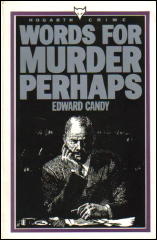Mon 1 Jun 2009
THE GOLDEN AGE OF BRITISH MYSTERY FICTION, PART VIII – Reviews by Allen J. Hubin.
Posted by Steve under Columns , Reviews[2] Comments
Reviews by Allen J. Hubin.

Edward Candy (Barbara Alison Boodson Neville, 1925-1993) spaced her mysteries widely: two in the first part of the 1950s were followed by two more in the 1970s. Her Words for Murder, Perhaps (Gollancz, 1971; Hogarth Press, 1985) is subtitled “A Detective Story,” but as the most recently published book among those being now reviewed, it is not one in the Golden Age sense: it would appear not to be the author’s objective to fairly challenge the reader.
But the tale is quite a pleasant one, a neat puzzle in an academic setting. Gregory Roberts (misidentified on the dust jacket as Robert Gregory) lectures at Bantwich University, and teaches also in the “Extra-Mural” (adult education) department.
He’s about 40, living with his mother after barely surviving a disastrous marriage and ensuing cuckolding, attempted suicide, psychiatric treatment, and divorce. Now his cuckolder and ex-wife’s present husband disappears, and the ex-wife receives a typewritten excerpt from an elegy in the mail.
Signs seem to point to Roberts, who’s presenting Detective Fiction to a class of adults, including Nan Jones, a widow who seems to be reviving the youth of his soul. Then a fellow extramural lecturer dies of cyanide, amidst evidences of another elegy. Police continue to sniff about, Roberts fears his life is coming unglued, and death marches on…
Death on the Cliff (Benn, 1932) is my first exposure to Thomas Cobb, who produced a number of works in our field during the Golden Age. Cliff is not a brilliant representative of its hallowed era: the puzzle is neither baffling nor compelling, the detection is slight, the people are not fascinating, and the rural English setting is ordinary.
Lady Roperson, whose 50ish husband is straying regularly from the connubial fold, is found dead on the rocks at the bottom of a cliff near their home. “Misadventure,” says the coroner’s jury – but Margaret Fairbrook, the dead woman’s daughter, immediately turns on her step-father, and Susannah Roperson (his daughter) develops an awful sense that murder has been done. Especially after a second death at almost the same spot as the first.
A private detective (once of the Yard) comes into the picture but plays a minor role. The truth emerges as Susannah comes to ask the right questions of the right people.

It’s been established that Sefton Kyle was an alter ego for Roy Vickers, who achieved a certain currency in this country when discovered by Ellery Queen. So I was interested to try one of the Kyle novels (none of which was ever published in this country): Red Hair (Jenkins, 1933).
Although from the publisher’s plot summary this appeared to be wholly non-criminous, a perusal proved this not to be the case. A murder occurs early and is pivotal to resulting events (though the reader knows at once who did it), and Kyle/Vickers/David Durham’s series Insp. Rason is our contact with Scotland Yard. (Rason’s adventures were chronicled under all three bylines, although the good inspector’s first initial seems to vary from book to book.)
The book is basically a gothic, and provides all the frustrations of the species. Secretary Patricia Ridge marries her politically rising boss, Sir Brennan Grantley, then discovers his first wife – long thought dead – has resurfaced.
Instead of confiding in Grantley, she tries to save his career, embarking on a course dotted with deception, theft and murder – a quagmire in which her every effort at extrication results in increased danger. Of course, all ends well as expected. Not recommended.
Charles Ashton was another Golden Age practitioner not known in this country. My first sampling was Death Greets a Guest (Nicholson & Watson, 1936).
Here a regular meeting of a rural archeological society at Squire Eastwood’s Heatherling Hall is interrupted by a sudden downpour. And by murder: a guest, an artist who accompanied a regular member, is found shot in Eastwood’s summerhouse.
It seems that no member can be guilty, that no motive exists, and that premeditation could not have been possible. Colonel Bretherton, Chief Constable, and Inspector Williams are baffled, but Major Jack Atherley, champion cricketeer and amateur sleuth, is on hand to sort matters out.
Competent, readable, pleasant, and quite forgettable.
NOTE: Go here for the previous installment of this column. Unfortunately this marks the end of this particular grouping of reviews, which were first published on the main Mystery*File website some four years ago. It was my thought that reprinting them here on the blog would bring fresh attention to them. By all accounts, it has. Thanks to everyone for their comments over the entire eight installments!
June 2nd, 2009 at 4:54 pm
This whole series was really fascinating!
It was great that it alerted us to so many forgotten authors.
June 2nd, 2009 at 6:18 pm
Agreed. Not all of the books were gems, obviously, or they wouldn’t have been as obscure as they are.
But it’s great to read about them, anyway, just in case we come across them — and Al did make quite a few of them sound quite appealing.
— Steve